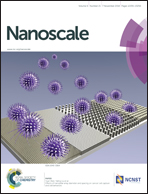Effect of core quantum-dot size on power-conversion-efficiency for silicon solar-cells implementing energy-down-shift using CdSe/ZnS core/shell quantum dots†
Abstract
Silicon solar cells mainly absorb visible light, although the sun emits ultraviolet (UV), visible, and infrared light. Because the surface reflectance of a textured surface with SiNX film on a silicon solar cell in the UV wavelength region (250–450 nm) is higher than ∼27%, silicon solar-cells cannot effectively convert UV light into photo-voltaic power. We implemented the concept of energy-down-shift using CdSe/ZnS core/shell quantum-dots (QDs) on p-type silicon solar-cells to absorb more UV light. CdSe/ZnS core/shell QDs demonstrated clear evidence of energy-down-shift, which absorbed UV light and emitted green-light photoluminescence signals at a wavelength of 542 nm. The implementation of 0.2 wt% (8.8 nm QDs layer) green-light emitting CdSe/ZnS core/shell QDs reduced the surface reflectance of the textured surface with SiNX film on a silicon solar-cell from 27% to 15% and enhanced the external quantum efficiency (EQE) of silicon solar-cells to around 30% in the UV wavelength region, thereby enhancing the power conversion efficiency (PCE) for p-type silicon solar-cells by 5.5%.


 Please wait while we load your content...
Please wait while we load your content...